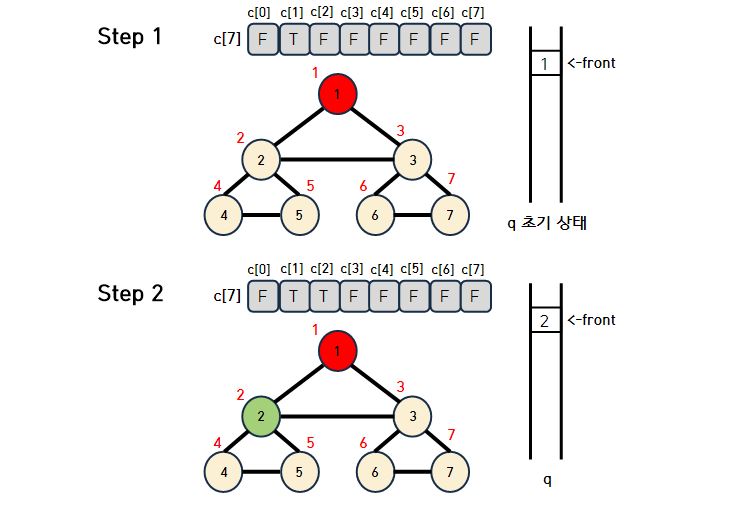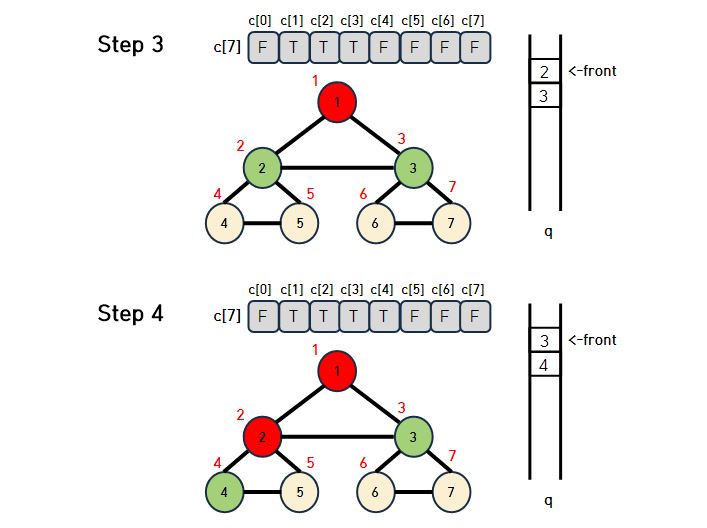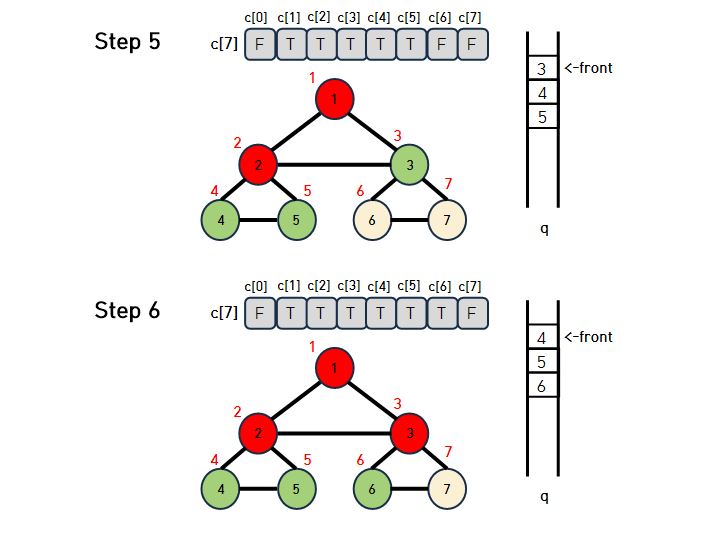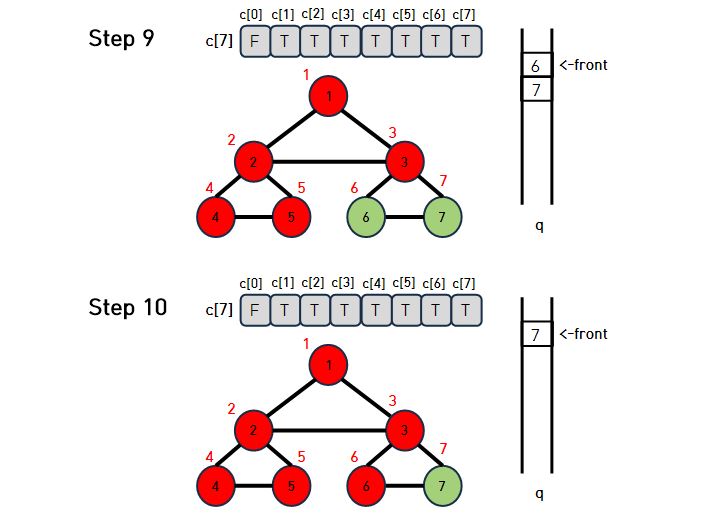너비 우선 탐색(BFS, Breadth First Search)
- 다차원 배열에서 각 칸을 방문할 때 너비를 우선으로 방문하는 알고리즘
- BFS는 방문한 노드들을 차례로 저장하고 꺼낼 수 있는 자료구조인 큐(Queue)를 사용 한다.
- BFS는 다차원 배열의 거리 계산 및 순회하는데 사용된다.
- 너비 우선 탐색(Breadth-first search, BFS)은 ‘맹목적 탐색방법’ 의 하나이다.
- 맹목적 탐색 이란, 이미 정해진 순서에 따라 상태 공간 그래프를 점차 형성해 가면서 해를 탐색하는 방법을 말한다.
- 루트 노드 (혹은 다른 임의의 노드) 에서 시작해 인접한 노드를 먼저 탐색하는 방법.
- 더 이상 방문하지 않은 정점이 없을 때까지 방문하지 않은 모든 정점들에 대해서도 너비 우선 검색을 적용한다.
두 노드 사이의 최단 경로 혹은 임의의 경로를 찾고 싶을 때 이 방법을 선택한다.
- 재귀적으로 동작하지 않는다.
- ‘Prim’, ‘Dijkstra’ 알고리즘과 유사하다.
- 출발노드에서 목표노드까지의 최단 길이 경로를 보장 한다.
- 그래프 탐색의 경우 어떤 노드를 방문했었는지 여부를 반드시 검사 해야한다. 그렇지 않으면 무한루프에 빠질 위험이 있다.(단점3)
- 단점
- 경로가 매우 길 경우 에는 탐색 가지가 급격히 증가함에 따라 보다 많은 기억 공간을 필요로 하게 된다.
- 해가 존재하지 않는다면 유한 그래프(finite graph)의 경우에는 모든 그래프를 탐색한 후에 실패로 끝난다.
- 무한 그래프(infinite graph)의 경우에는 결코 해를 찾지도 못하고, 끝내지도 못한다.
- 맹목적 탐색 이란, 이미 정해진 순서에 따라 상태 공간 그래프를 점차 형성해 가면서 해를 탐색하는 방법을 말한다.
두 노드 사이의 최단 경로 혹은 임의의 경로를 찾고 싶을 때 이 방법을 선택한다.
- 경로가 매우 길 경우 에는 탐색 가지가 급격히 증가함에 따라 보다 많은 기억 공간을 필요로 하게 된다.
- 해가 존재하지 않는다면 유한 그래프(finite graph)의 경우에는 모든 그래프를 탐색한 후에 실패로 끝난다.
- 무한 그래프(infinite graph)의 경우에는 결코 해를 찾지도 못하고, 끝내지도 못한다.
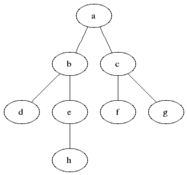
너비 우선 탐색(Breath First Search)의 알고리즘 예시
BFS 구현
아래와 같은 형태의 그래프가 주어질때 BFS를 구현 해보겠습니다.
1─2─5
|/ \│
3 4
|\
6─7
C++ BFS 구현 예시1
인접 리스트 가 입력 값으로 주어진 상황에서 C++ STL Library로 구현한 BFS 코드입니다.
#include <iostream>
#include <queue>
#include <vector>
using namespace std;
// 1~7번 노드의 방문 처리 하기 위한 배열
int c[7];
vector<int> a[8];
void bfs(int start){
queue<int> q;
q.push(start);
c[start] = true;
//search
while(!q.empty()){
int x = q.front();
q.pop();
printf("%d ", x);
for(int i = 0; i < a[x].size(); i++){
int y = a[x][i];
// 방문한 상태가 아니라면 큐에 넣어준다.
if(!c[y]){
q.push(y);
c[y] = true;
}
}
}
}
int main(void){
int input[8][2] = {
{1,2},{1,3},{2,3},{2,5},{2,4},{3,6},{4,5},{6,7}
};
//data input
for (int i = 0; i < 8; i++) {
a[input[i][0]].push_back(input[i][1]);
a[input[i][1]].push_back(input[i][0]);
}
bfs(1);
return 0;
}
C++ BFS 구현 예시2
인접 행렬 이 입력 값으로 주어진 상황에서 C++로 구현한 BFS 코드입니다.
#include <bits/stdc++.h>
using namespace std;
#define X first
#define Y second // pair에서 first, second를 줄여서 쓰기 위해서 사용
int board[502][502] =
{
{1,1,1,0,1,0,0,0,0,0},
{1,0,0,0,1,0,0,0,0,0},
{1,1,1,0,1,0,0,0,0,0},
{1,1,0,0,1,0,0,0,0,0},
{0,1,0,0,0,0,0,0,0,0},
{0,0,0,0,0,0,0,0,0,0},
{0,0,0,0,0,0,0,0,0,0}
}; // 1이 파란 칸, 0이 빨간 칸에 대응
bool vis[502][502]; // 해당 칸을 방문했는지 여부를 저장
int n = 7, m = 10; // n = 행의 수, m = 열의 수
int dx[4] = {1,0,-1,0};
int dy[4] = {0,1,0,-1}; // 상하좌우 네 방향을 의미
int main(void){
ios::sync_with_stdio(0);
cin.tie(0);
queue<pair<int,int> > Q;
vis[0][0] = 1; // (0, 0)을 방문했다고 명시
Q.push({0,0}); // 큐에 시작점인 (0, 0)을 삽입.
while(!Q.empty()){
pair<int,int> cur = Q.front(); Q.pop();
cout << '(' << cur.X << ", " << cur.Y << ") -> ";
for(int dir = 0; dir < 4; dir++){ // 상하좌우 칸을 살펴볼 것이다.
int nx = cur.X + dx[dir];
int ny = cur.Y + dy[dir]; // nx, ny에 dir에서 정한 방향의 인접한 칸의 좌표가 들어감
if(nx < 0 || nx >= n || ny < 0 || ny >= m) continue; // 범위 밖일 경우 넘어감
if(vis[nx][ny] || board[nx][ny] != 1) continue; // 이미 방문한 칸이거나 파란 칸이 아닐 경우
vis[nx][ny] = 1; // (nx, ny)를 방문했다고 명시
Q.push({nx,ny});
}
}
}
Java BFS 구현 예시1
인접 리스트 가 입력 값으로 주어진 상황에서 Java Collection으로 구현한 BFS 코드입니다.
import java.io.BufferedReader;
import java.io.InputStreamReader;
import java.util.LinkedList;
import java.util.Queue;
class Main {
static int[][] input = {
{1,2},{1,3},{2,3},{2,5},{2,4},{3,6},{4,5},{6,7}
};
static LinkedList<Integer>[] board = new LinkedList[8];
static boolean[] visit = new boolean[8];
public static void bfs(int start) {
Queue<Integer> q = new LinkedList<>();
q.add(start);
visit[start] = true;
while(!q.isEmpty()) {
int cur = q.poll();
System.out.print(cur + " ");
for (int i = 0; i < board[cur].size(); i++) {
int next = board[cur].get(i);
if(!visit[next]) {
q.add(next);
visit[next] = true;
}
}
}
}
public static void main(String[] args) throws Exception {
BufferedReader br = new BufferedReader(new InputStreamReader(System.in));
//init
for (int i = 1; i <= 7; i++) {
board[i] = new LinkedList<>();
}
//input
for (int i = 0; i < input.length; i++) {
board[input[i][0]].add(input[i][1]);
board[input[i][1]].add(input[i][0]);
}
bfs(1);
br.close();
}
}
BFS 문제 유형(+응용 유형)
- Flood Fill
- 거리 측정
- 시작점이 여러 개일 때
- 시작점이 두 종류일 때
- 1차원에서의 BFS
주의할점
- 시작점에 방문했다는 표시를 남기지 않는다.
- 큐에 넣을 때 방문했다는 표시를 하는 대신 큐에서 빼낼 때 방문했다는 표시를 남겼다.
- 이웃한 원소가 범위를 벗어났는지에 대한 체크를 잘못했다.
